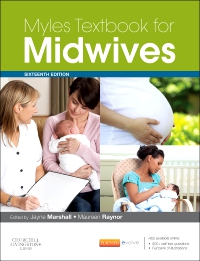
Myles Textbook for Midwives - Paegburst eBook on VitalSource, 16th Edition
Elsevier eBook on VitalSource

Now $50.34
The sixteenth edition of this seminal textbook, Myles Textbook for Midwives, has been extensively revised and restructured to ensure that it reflects current midwifery practice, with an increased focus on topics that are fundamental to midwifery practice today. The book comes with Elsevier EVOLVE ancillaries – an online learning package which consists of 500 self-assessment questions and answers and a fully downloadable image bank.
Newer Edition Available
Myles Textbook for Midwives Elsevier eBook on Vitalsource
-
- Designed to enable midwifery practitioners to provide safe and competent care, which is tailored to the patient’s individual needs
- Extensively illustrated to assist visual learning with additional ‘pull out’ textboxes to highlight key information
- Streamlined chapters with similar themes and approach help consolidate learning
- Reflects all modern midwifery curricula by presenting a strong emphasis on evidenced-based practice and the use of technology
- Over 500 on-line multiple-choice questions to enable readers to test their knowledge
- Offers a full image bank of downloadable illustrations to assist with personal projects and/or further learning
- References, Further Reading and Useful Websites promote further learning
- Glossary of Terms and Acronyms provide simple definitions of more complex terminologies
-
- Full colour illustrations now used throughout the book, in response to student feedback
- Contains many new chapters, some of which are authored by members of the multi-professional team
- Up-to-date guidance on professional regulation, midwifery supervision, legal and ethical issues, risk management and clinical governance
- Recognition that midwives increasingly care for women with complex health needs, in a multicultural society
- Examination of the dilemmas involved in caring for women with a raised body mass index
- Chapter on optimising care of the perineum for women with perineal trauma, including those who have experienced female genital mutilation
- Guidance to support the trend for midwives to undertake the neonatal physical examination of the healthy term infant
- Additional coverage of basic neonatal resuscitation
-
SECTION 1 THE MIDWIFE IN CONTEXT
1 The midwife in contemporary midwifery practice
2 Professional issues concerning the midwife and midwifery practice
SECTION 2 HUMAN ANATOMY AND REPRODUCTION
3 The female pelvis and the reproductive organs
4 The female urinary tract
5 Hormonal cycles: fertilization and early development
6 The placenta
7 The fetus
SECTION 3 PREGNANCY
8 Antenatal education for birth and parenting
9 Change and adaptation in pregnancy
10 Antenatal care
11 Antenatal screening of the mother and fetus
12 Common problems associated with early and advanced pregnancy
13 Medical conditions of significance to midwifery practice
14 Multiple pregnancy
SECTION 4 LABOUR
15 Care of the perineum, repair and female genital mutilation
16 Physiology and care during the first stage of labour
17 Physiology and care during the transition and second stage phases of labour
18 Physiology and care during the third stage of labour
19 Prolonged pregnancy and disorders of uterine action
20 Malpositions of the occiput and malpresentations
21 Operative births
22 Midwifery and obstetric emergencies
SECTION 5 PUERPERIUM
23 Physiology and care during the puerperium
24 Physical health problems and complications in the puerperium
25 Perinatal mental health
26 Bereavement and loss in maternity care
27 Contraception and sexual health in a global society
SECTION 6 THE NEONATE
28 Recognizing the healthy baby at term through examination of the newborn screening
29 Resuscitation of the healthy baby at birth: the importance of drying, airway management and establishment of breathing
30 The healthy low birth weight baby
31 Trauma during birth, haemorrhages and convulsions
32 Congenital malformations
33 Significant problems in the newborn baby
34 Infant feeding
Glossary of selected terms



 as described in our
as described in our 